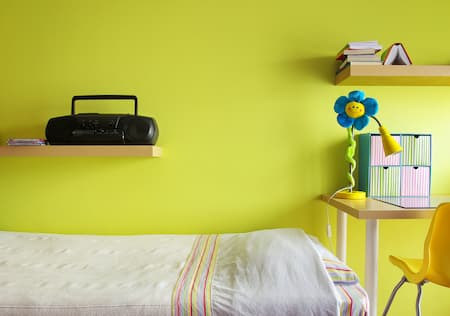Top Ten Tips

Having trouble picking the perfect paint color for your Reno home decorating project? Not sure what type of paint you should use? Don’t feel bad — even your Reno professional painter need help from time to time.
The paint experts at Pratt & Lambert frequently field questions from home decorators and interior designers. Here’s a list of their top 10 questions and answers to help you better understand the basics of color and paint selection and transform your weekend interior painting project into a professional quality job.
1. What is the best way to decide which color is best for my room?
The first step is determining your color scheme by examining your existing furniture, window treatments, and other accessories (or shop for these items first). Choose your favorite colors in these items and visit your paint dealer to get coordinating color chips. Look at the color chips in the daylight and at night so you will see how lighting will affect your color choices. As a last resort, you might want to buy a quart of your chosen color and test it on one of your walls.
2. My room has a chair rail and I am using two colors. Which one goes where?
If you want an open, airy look, always paint the portion of the wall below the chair rail with the darker color. This allows the lighter color to dominate.
3. Should trim work be painted the same color as the walls, or a different shade?
The answer to this question depends on what you are trying to achieve with your room. Use the same color on the trim if you are trying to disguise ordinary or unattractive trim work, or if you are trying to create a uniform, monochromatic look. Use a lighter or darker color to accentuate trim work or to add subtle hints or bold flashes of color to your room.
4. Will the paint I chose look lighter or darker on the wall?
Over a larger surface area, most colors appear darker. It’s a good idea to choose colors a shade or two lighter than what you want. Clean, bright colors can appear either lighter or darker depending on the surrounding colors and lighting in the room.
5. I’ve just finished painting my room and the color is bolder than I expected. How can I soften the look?
Try applying a lighter or more muted color over the original color using a design technique such as rag rolling, sponging, or color washing.
6. How do colors affect a room’s size?
Generally, strong, warm colors like reds, oranges and yellows tend to close a space. These colors are known as advancing colors because they jump out and meet the eye. Conversely, receding colors like blue, green and violet tend to make a room look larger because they “stand back” visually. However, the darkest values of the receding colors, like navy blue or hunter green, also tend to have a diminishing effect on a room’s size. Small rooms are best made to appear larger by painting them white or a light neutral color.
7. What color should I paint my ceiling?
It is customary to paint ceilings white or off-white. This creates the illusion of higher ceilings and a more open space. Medium to dark colors will create the illusion of lowering the ceiling, which can create a cozy look if the ceiling is higher than usual. With normal height ceilings, medium and dark colors could close in the area too much creating a cave-like appearance.
8. What’s the difference between different types of paint finishes and which finish works best where?
- Flat finishes have no shine, making them ideal for hiding minor surface imperfections. While traditional flat finishes are not usually stain-resistant, Pratt & Lambert Accolade is designed to provide maximum stain resistance while maintaining a beautiful flat finish.
- Eggshell or velvet finishes work in just about any room. They are easier to clean than flat finishes and offer a soft glow that warms up any room.
- Satin or semi-gloss finishes are easy to clean and are good for highlighting architectural details. They work well in kitchens, baths, and on doors and trim.
- Gloss finishes are shiny and can be scrubbed, so they are perfect for doors, trim and specialty uses.
- Sheen terminologies vary by manufacturer.
9. What is the difference between oil-based and water-based paint, and what are the advantages of each?
Alkyd, or oil-based paint penetrates wood better than latex (water-based) paint and won’t stick when you keep your doors and windows shut for the winter. For the bulk of most jobs, latex (water-based) paint is the better choice. It dries faster, doesn’t yellow and can be cleaned up with soap and water when you break for the day.
10. How do I determine the amount of paint I’ll need for a particular job?
The first step is to add the width of all walls in the room together. Multiply this sum by the height of one wall from floor to ceiling. Take this total number and subtract the total area of your doors, windows, archways, etc. to get the exact area of wall space you will paint. A flat surface usually requires one gallon for every 400 square feet. Take into account the number of coats you will need to do the job right. Blue and yellow are hard colors to cover up with just one coat.
